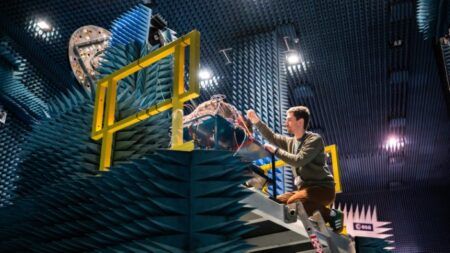Steamjet Space Systems’ is to test and validate its water-based propulsion system, which is being developed for use with small satellites such as CubeSats, at the University of Southampton in the UK.
The Steamjet system uses water as a propellant to create thrust in a low power resistojet. Unlike high pressure cold gas thrusters or hazardous monopropellant systems, the Steamjet propulsion unit is safe for launch-site operations, or storage within the International Space Station, reducing mission risk.
The propulsion system has a tuna-can shape that enables its installation on the outside of a CubeSat, providing more space for its payload or other subsystems within the satellite.
Marco Pavan, managing director of Steamjet Space Systems said, “CubeSats were initially used in a disposable way with no propulsion, mainly for technology demonstration missions. Companies and governments are now looking at them for commercial and scientific missions, however the absence of propulsion capabilities is limiting their range of applications.
“Our water-based propulsion system converts water to steam to produce an extremely safe and affordable system. In addition, the installation of the propulsion system outside of the nanosatellite leaves more space inside.
“To qualify our technology, we needed a series of tests to prove effective operations in space conditions and the University of Southampton, with its expertise in electric propulsion, has everything that we need to qualify the system. We’re also planning tests in space.”
The Steamjet system will be tested in the David Fearn Electric Propulsion Laboratory and Thermal Vacuum Test Facility at the University of Southampton, in the environmental vibration test facility and will be scanned using its µ-VIS High Resolution X-Ray Computed Tomography (CT) facility.
Dr Charlie Ryan, Lecturer in Astronautics at the University of Southampton said, “With space-enabled capabilities including simulations, vacuum chambers and thermal chambers, we offer comprehensive facilities and expertise in resistojet and electric propulsion systems.
“We can validate performances of the basic thruster design and see how it reacts to an in-orbit environment through thermo cycling. This project will be the first time that we’ve used the vacuum chamber to verify a thruster and this will enable us to validate the Steamjet Space thruster as suitable for space flight, subject to ESA/NASA standards.”
The project will be funded by a grant from the £4.8 million (US$6.34 million) SPRINT (SPace Research and Innovation Network for Technology) program that provides access to academic space expertise and testing facilities. The SPRINT network is a group of UK universities that have capabilities in testing and development of space technology which is led by the University of Leicester and includes the University of Edinburgh, The Open University, University of Southampton and University of Surrey.





